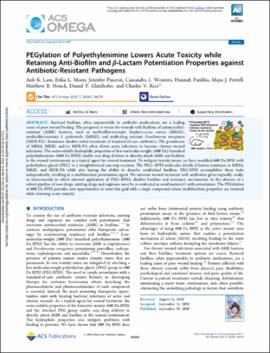| dc.contributor.author | Lam, Anh K. | |
| dc.contributor.author | Moen, Erika L. | |
| dc.contributor.author | Pusavat, Jennifer | |
| dc.contributor.author | Wouters, Cassandra L. | |
| dc.contributor.author | Panlilio, Hannah | |
| dc.contributor.author | Ferrell, Maya J. | |
| dc.contributor.author | Houck, Matthew B. | |
| dc.contributor.author | Glatzhofer, Daniel T. | |
| dc.contributor.author | Rice, Charles V. | |
| dc.date.accessioned | 2021-04-08T21:07:38Z | |
| dc.date.available | 2021-04-08T21:07:38Z | |
| dc.date.issued | 2020-09-29 | |
| dc.identifier.citation | Anh K. Lam, Erika L. Moen, Jennifer Pusavat, Cassandra L. Wouters, Hannah Panlilio, Maya J. Ferrell, Matthew B. Houck, Daniel T. Glatzhofer, and Charles V. Rice. PEGylation of Polyethylenimine Lowers Acute Toxicity while Retaining Anti-Biofilm and β-Lactam Potentiation Properties against Antibiotic-Resistant Pathogens. ACS Omega 2020 5 (40), 26262-26270DOI: 10.1021/acsomega.0c04111 | en_US |
| dc.identifier.uri | https://hdl.handle.net/11244/329117 | |
| dc.description.abstract | Bacterial biofilms, often impenetrable to antibiotic medications, are a leading cause of poor wound healing. The prognosis is worse for wounds with biofilms of antimicrobial-resistant (AMR) bacteria, such as methicillin-resistant Staphylococcus aureus (MRSA), methicillin-resistant S. epidermidis (MRSE), and multi-drug resistant Pseudomonas aeruginosa (MDR-PA). Resistance hinders initial treatment of standard-of-care antibiotics. The persistence of MRSA, MRSE, and/or MDR-PA often allows acute infections to become chronic wound infections. The water-soluble hydrophilic properties of low-molecular-weight (600 Da) branched polyethylenimine (600 Da BPEI) enable easy drug delivery to directly attack AMR and biofilms in the wound environment as a topical agent for wound treatment. To mitigate toxicity issues, we have modified 600 Da BPEI with polyethylene glycol (PEG) in a straightforward one-step reaction. The PEG–BPEI molecules disable β-lactam resistance in MRSA, MRSE, and MDR-PA while also having the ability to dissolve established biofilms. PEG-BPEI accomplishes these tasks independently, resulting in a multifunction potentiation agent. We envision wound treatment with antibiotics given topically, orally, or intravenously in which external application of PEG–BPEIs disables biofilms and resistance mechanisms. In the absence of a robust pipeline of new drugs, existing drugs and regimens must be re-evaluated as combination(s) with potentiators. The PEGylation of 600 Da BPEI provides new opportunities to meet this goal with a single compound whose multifunction properties are retained while lowering acute toxicity. | en_US |
| dc.description.sponsorship | We want to thank Dr. Phil Bourne and acknowledge the use of the Protein Production Core (PPC) at the University of Oklahoma, Norman. PPC is supported by an Institutional Development Award (IDeA) from the National Institute of General Medical Sciences of the National Institutes of Health under grant number P20GM103640.
Open Access fees paid for in whole or in part by the University of Oklahoma Libraries. | en_US |
| dc.language | en_US | en_US |
| dc.rights | Attribution 4.0 International | * |
| dc.rights.uri | https://creativecommons.org/licenses/by/4.0/ | * |
| dc.subject | Biofilms | en_US |
| dc.subject | Antimicrobial agents | en_US |
| dc.subject | Bacteria | en_US |
| dc.subject | Pegylation | en_US |
| dc.subject | Toxicity | en_US |
| dc.title | PEGylation of Polyethylenimine Lowers Acute Toxicity while Retaining Anti-Biofilm and β-Lactam Potentiation Properties against Antibiotic-Resistant Pathogens | en_US |
| dc.type | Article | en_US |
| dc.description.peerreview | Yes | en_US |
| dc.identifier.doi | 10.1021/acsomega.0c04111 | en_US |
| ou.group | College of Arts and Sciences::Department of Chemistry and Biochemistry | en_US |


